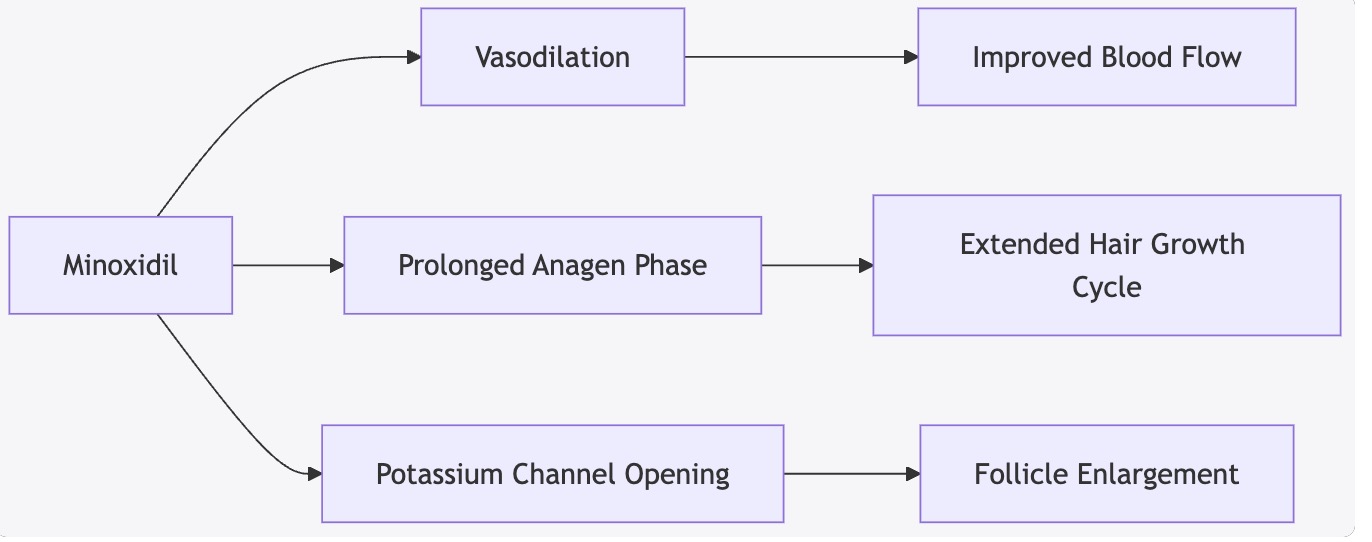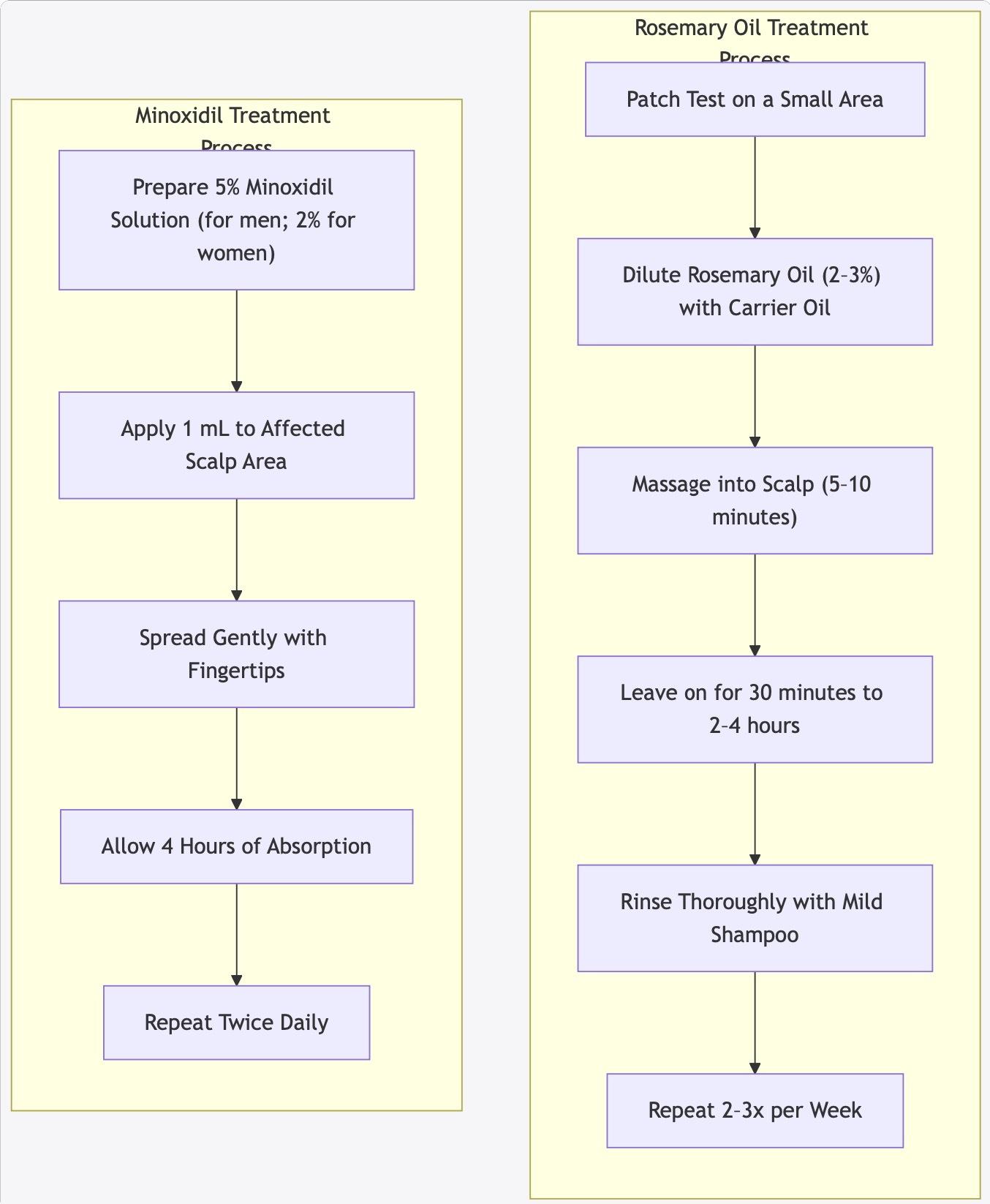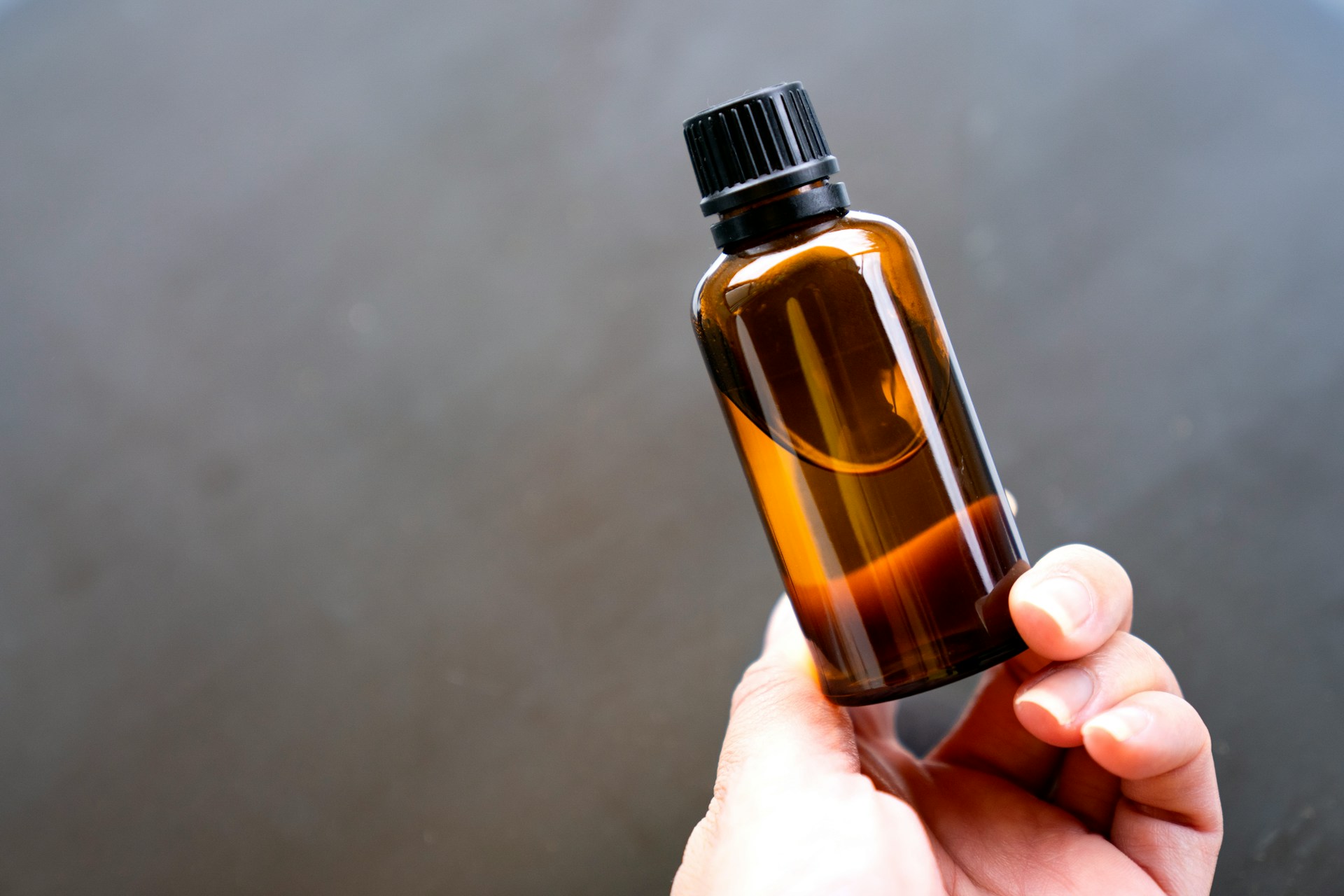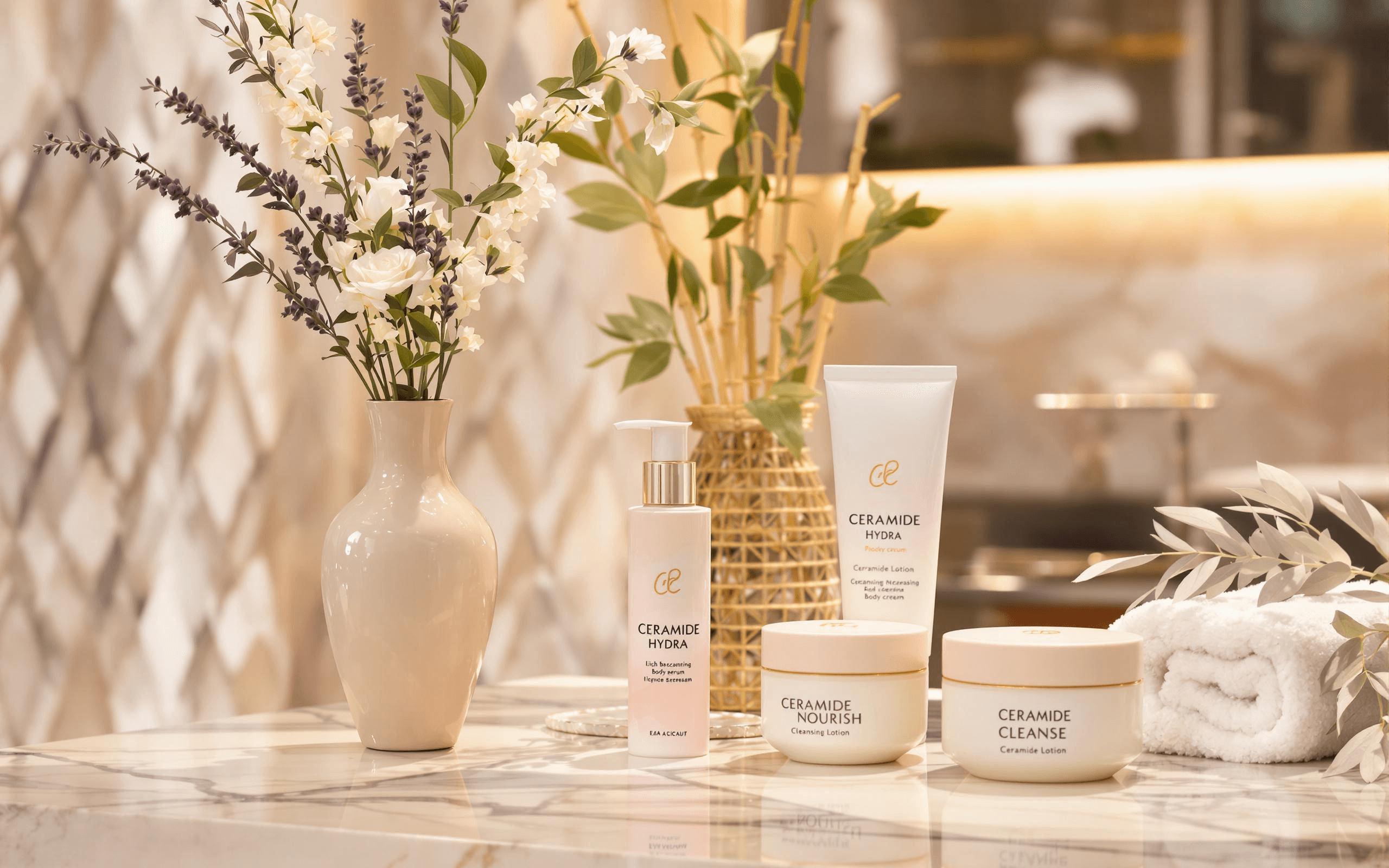Comparative Analysis of Rosemary Oil Vs Minoxidil for Hair Growth
This article examines the effectiveness, side effects, ease of application, and user experiences—both scientific evidence and anecdotal—of using rosemary essential oil (with a carrier oil) compared to minoxidil for hair growth treatments.
Table of Contents
- Introduction
- Effectiveness Comparison
- Mechanisms of Action
- Safety and Side Effects
- Application Protocols and Practical Use
- Cost Analysis and Accessibility
- Expert Opinion and Recommendations
- Limitations and Considerations
- Conclusion
1. Introduction
Hair loss is a concern that affects millions worldwide and can lead to significant emotional and psychological distress. Among the many options available, natural remedies and pharmaceutical treatments have gained both popularity and scrutiny. Two commonly discussed treatments are rosemary essential oil (when diluted with a carrier oil) and minoxidil. Rosemary oil, derived from the Rosmarinus officinalis plant, is reputed for its natural benefits that include enhanced scalp microcirculation and anti-inflammatory activity. In contrast, minoxidil is a well-established, FDA-approved medication that has been extensively researched for its hair growth–stimulating properties.
This article provides an in-depth comparative analysis of rosemary oil (with an appropriate carrier oil) versus minoxidil, focusing on various aspects including their effectiveness, mechanisms of action, safety profiles, usage protocols, cost implications, and the recommendations from experts. The analysis is supported by research findings, clinical studies, and expert commentary extracted from multiple sources.
2. Effectiveness Comparison
2.1 Overview of Hair Growth Efficacy
Clinical and anecdotal evidence alike has led to debates concerning the effectiveness of rosemary oil compared to minoxidil in promoting hair growth. A landmark study conducted in 2015 compared rosemary oil with 2% minoxidil over a six-month period. The findings indicated that the rosemary oil group experienced a significant increase in hair count (approximately a 5.5% increase), comparable to the group using 2% minoxidil. However, it is important to note that many experts now argue that the 5% minoxidil formulation is more effective than its 2% counterpart—particularly in male pattern baldness—demonstrating much higher rates of hair regrowth.
2.2 Comparison Data Table
| Aspect | Rosemary Oil + Carrier Oil | Minoxidil |
|---|---|---|
| Hair Growth Efficacy | Approximately 5.5% increase in hair count over six months when compared to 2% minoxidil | 2% formulation: modest improvements (approximately 1.7% increase); 5% formulation: up to 45% greater hair regrowth than 2% |
| Time Frame | Typically noticeable after 6 months of consistent use | Improvements generally emerge after 4–6 months of twice-daily use |
| Clinical Backing | Limited to small-scale studies and anecdotal evidence; potential benefits in mild hair thinning | Extensively studied; FDA-approved with robust clinical trials documenting responses in androgenetic alopecia |
| User Type | Best suited for individuals with early or mild thinning or those seeking a natural alternative | Recommended for both genders experiencing moderate to severe hair loss |
The numbers and percentages are derived from the comparative trials and are subject to individual variations and clinical specifics.
2.3 Discussion
In summary, while rosemary oil has shown potential benefits in hair regrowth—especially in individuals experiencing mild thinning—the proven efficacy of minoxidil is clearly documented through larger clinical trials. It is critical to understand that the comparison between rosemary oil and minoxidil is not entirely straightforward, given the differences in concentrations and the nature of hair loss (e.g., androgenetic alopecia versus temporary shedding). Therefore, while rosemary oil may serve as a safe natural remedy with fewer side effects, minoxidil, particularly at higher concentrations, remains the treatment of choice for more pronounced hair loss conditions.
3. Mechanisms of Action
Understanding the distinct mechanisms through which both treatments work is fundamental to evaluating their benefits and limitations.
3.1 Rosemary Oil Mechanism
The active compounds in rosemary essential oil, such as carnosic acid, are believed to play a key role in stimulating hair growth through several biological processes:
- Improved Scalp Microcirculation: Carnosic acid helps increase blood flow to the scalp, ensuring that hair follicles receive more oxygen and essential nutrients.
- Antioxidant Activity: The antioxidant properties of rosemary oil reduce oxidative stress on the scalp, potentially preventing damage to the hair follicles.
- Anti-inflammatory Effects: By reducing inflammation, rosemary oil may help in preventing follicle damage and subsequently support a healthy growth environment.
To illustrate these pathways, consider the following flowchart:

Figure 1: Flowchart Illustrating the Mechanism Behind Rosemary Oil’s Influence on Hair Follicle Health .
3.2 Minoxidil Mechanism
Minoxidil functions primarily through its action as a potent vasodilator. Its mechanisms include:
- Vasodilation: Minoxidil enlarges blood vessels in the scalp which leads to improved blood circulation and increased delivery of oxygen and nutrients to hair follicles.
- Prolonged Anagen Phase: It helps in extending the growth (anagen) phase of the hair cycle, thereby allowing hair follicles more time to grow new hair.
- Potassium Channel Opening: By opening potassium channels in the follicular cells, minoxidil promotes follicle enlargement and stimulates hair regrowth.
A diagram that captures these mechanisms is presented below:

Figure 2: Flowchart Showing the Mechanism of Minoxidil’s Action on Hair Growth .
3.3 Comparative Discussion
When comparing both mechanisms, it becomes evident that while minoxidil works largely through vascular modulation and cell proliferation, rosemary oil’s approach is more holistic. The natural compounds in rosemary reduce inflammation and oxidative stress, indirectly fostering a healthy scalp environment. Both treatments ultimately aim to nourish the hair follicle, but they do so through different physiological routes. Consequently, these differences also reflect in their side-effect profiles and usage considerations.
4. Safety and Side Effects
4.1 Overview of Side Effect Profiles
Because both treatments operate through distinct formulations and mechanisms, their safety profiles vary considerably. Users must be well informed about the potential side effects when selecting an appropriate treatment.
4.2 Side Effects Associated with Rosemary Oil
Although rosemary oil is a natural alternative, its use is not entirely devoid of risks. Common safety considerations include:
- Irritation and Allergic Reactions: Undiluted rosemary oil may cause skin irritation or allergic dermatitis. A patch test is strongly recommended before regular application to ensure that the scalp does not react adversely.
- Microflora Disruption: Leaving the oil on the scalp for extended periods (such as overnight) might alter the natural scalp microflora, leading to itchiness and redness.
- Dilution Necessity: Proper dilution (usually 2–3% with a carrier oil) is essential to mitigate the risk of irritation and ensure even application across the scalp.
4.3 Side Effects of Minoxidil
Minoxidil, being a pharmacologically active compound, has been associated with several adverse effects:
- Scalp Irritation: Users often report itching, redness, and a burning sensation at the site of application, particularly with the 5% formulation.
- Unwanted Hair Growth: Some users may experience hypertrichosis (unwanted hair growth) on non-scalp areas, an effect more pronounced with minoxidil use.
- Systemic Effects: Although rare, systemic hypotension and changes in heart rate have been observed due to the vasodilatory effects of minoxidil.
- Discontinuation Rebound: Upon discontinuing minoxidil, the gains in hair regrowth can be quickly lost as the hair growth cycle reverts to its previous state.
4.4 Comparative Adverse Effects Table
| Side Effect Category | Rosemary Oil + Carrier Oil | Minoxidil (Especially 5%) |
|---|---|---|
| Scalp Irritation | Occasional mild irritation if undiluted (5–10% incidence) | Common; reported in 15–20% of users (itching, redness) |
| Allergic Reactions/Contact Dermatitis | Rare if diluted properly (2–3% incidence) | Low-to-moderate incidence; can cause allergic reactions in sensitive individuals |
| Unwanted Hair Growth | No reported cases when used topically on the scalp | Can occur on the face or other unintended areas (2–4%) |
| Systemic Effects | Largely absent when applied topically and in proper dilution | Possible hypotension, though rare and generally within safe limits |
The differences in side effect profiles underscore that while rosemary oil is generally well tolerated when diluted, minoxidil carries a higher risk of both local and, on rare occasions, systemic adverse effects .
5. Application Protocols and Practical Use
5.1 Guidelines for Using Rosemary Oil
When adopting rosemary oil as a treatment for hair loss, the following application protocol is recommended for safety and maximum efficacy:
- Perform a Patch Test:
Always test a small amount of the diluted oil on a localized area of the scalp before full application to confirm that no irritation or allergic reaction occurs. - Prepare the Mixture:
- Dilution Ratio: Mix 2–3% rosemary oil with a suitable carrier oil. For example, add 4–6 drops of rosemary oil per tablespoon (approximately 15 mL) of carrier oil like coconut, jojoba, or argan oil.
- Mixing: Ensure thorough mixing to achieve an even distribution of the active compounds.
- Application Steps:
- Part your hair to expose thinning or affected areas.
- Using your fingertips, gently massage the mixture into the scalp for at least 5–10 minutes to enhance blood circulation.
- Let the mixture sit on your scalp for a minimum of 30 minutes to ensure proper absorption. Some practitioners suggest treatments up to 2–4 hours, but caution against leaving it overnight in certain cases due to potential disruption of the scalp’s microflora.
- Rinse your hair thoroughly with a mild shampoo, often requiring a second wash to completely remove the oil.
- Frequency of Use:
Most dermatologists recommend using the rosemary oil treatment 2–3 times per week for the best results.
5.2 Guidelines for Minoxidil Application
The recommended procedure for minoxidil application is distinct and requires strict adherence for optimal results:
- Concentration Selection:
- For men, a 5% minoxidil solution is typically recommended due to its higher efficacy in stimulating hair regrowth.
- For women, a 2% solution is often preferred to minimize potential side effects while still benefiting from hair regrowth.
- Application Procedure:
- Apply approximately 1 mL of the minoxidil solution directly to the scalp in the area of hair thinning or loss.
- Use a gentle applicator or your fingertips to distribute the product evenly.
- Allow the minoxidil to be absorbed completely; avoid rinsing or washing the area for at least 4 hours after application to maximize absorption.
- Frequency of Use:
Minoxidil must be applied twice daily (morning and evening) to maintain safety and efficacy. Skipping applications may diminish the treatment’s benefits, and discontinuation often results in the loss of newly regrown hair.
5.3 Comparative Application Process Flowchart
Below is a side-by-side flowchart highlighting the step-by-step process for each treatment method:

Figure 3: Comparative Flowchart Detailing the Application Protocols for Rosemary Oil and Minoxidil .
6. Cost Analysis and Accessibility
An important consideration for many users is the cost of treatment and its sustained application over time. Here, we present a comparative cost analysis reflecting initial investment, ongoing costs, and compliance-related aspects.
6.1 Cost Comparison Table
| Treatment | Initial Investment | Ongoing Annual Cost | User Compliance |
|---|---|---|---|
| Rosemary Oil Regimen | $20–$50 (for a quality 100% pure oil and carrier oils) | $100–$150 (depending on frequency and brand quality) | Generally higher (around 65%) due to ease and natural approach |
| 5% Minoxidil (Over-the-Counter / Prescription Option) | $60–$80 (starter packs) | Approximately $500–$700 (considering twice-daily application) | Often lower (40–50%) due to stringent usage requirements and potential side effects |
| Prescription Combination Treatments (e.g., minoxidil with finasteride/dutasteride) | $100–$200 | $800–$1,200 | Typically 30–35% because of complexity and cost |
It is important to note that prices can vary significantly based on location, brand, and whether a healthcare professional is involved in the treatment planning.
6.2 Discussion of Accessibility
Rosemary oil is widely accessible and generally considered more economical, particularly for those with mild hair thinning who are looking for a natural remedy. The lower incidence of side effects also contributes to a better tolerance and compliance rate. Conversely, minoxidil (especially the 5% formulation) and prescription combinations have higher annual costs and may require a professional diagnosis and monitoring, but they deliver a higher efficacy level for more severe cases of hair loss.
7. Expert Opinion and Recommendations
Expert opinions help contextualize the use cases and advise on the suitability of each treatment according to the severity of hair loss and patient-specific conditions.
7.1 Dermatologist Insights
Dr. Aditi Shende, a board-certified dermatologist, notes that:
- For individuals experiencing minimal hair shedding (e.g., a few extra hairs during washing), rosemary oil can be an effective natural remedy provided that it is used appropriately and judiciously.
- In cases of more pronounced hair loss, such as noticeable bald patches or significant thinning, prescription medication like minoxidil (or combination therapy with finasteride/dutasteride) is advisable for early intervention and more marked treatment success.
7.2 Comparative Clinical Study Findings
A randomized clinical study comparing rosemary oil to 2% minoxidil found that both treatments could increase scalp hair count after six months. Notably, while rosemary oil showed a comparable percentage increase in hair count, it did so with fewer side effects—such as itching and irritation—thus making it a viable natural alternative for those with less severe androgenetic alopecia. However, the clinical literature strongly supports that 5% minoxidil significantly outperforms the 2% formulation, offering marked improvements in hair regrowth.
7.3 Combination and Adjunct Approaches
Some practitioners are now suggesting that combining both treatments with other mechanical stimulation techniques (for example, massaging or micro-needling) might yield improved results. A sample daily regimen might include minoxidil application in the morning and a rosemary oil scalp massage in the evening (2–3 times per week), thereby harnessing the synergistic effects of both products. The following mermaid diagram illustrates a potential combined treatment schedule:
Figure 4: Sample Combined Treatment Schedule Integrating Minoxidil and Rosemary Oil Protocols .
7.4 Summary of Expert Recommendations
- Mild Hair Loss:
- Consider starting with a natural approach using diluted rosemary oil. Monitor progress over a 6–8-month period and ensure proper patch testing to avoid adverse reactions.
- Moderate to Severe Hair Loss:
- Minoxidil (particularly the 5% formulation) is recommended due to its robust clinical evidence and higher efficacy rates.
- Combination Therapy:
- For enhanced outcomes, especially in cases where individual treatments yield modest improvements, a combined approach may be adopted under professional supervision.
8. Limitations and Considerations
8.1 Limitations of the Studies
While the comparative studies provide valuable insights, several limitations must be acknowledged:
- Study Concentration Issues:
- The 2015 study comparing rosemary oil with 2% minoxidil might not offer a completely fair comparison as the standard effective concentration for men is typically 5% minoxidil. This discrepancy highlights that rosemary oil was compared against a lower-efficacy minoxidil concentration.
- Sample Size and Control Groups:
- Many of the studies on rosemary oil are small-scale and may lack a robust control group to fully account for variables such as seasonality or natural hair cycle fluctuations.
- Quality Variability:
- The efficacy of rosemary oil can vary widely based on its purity, extraction method, and the carrier oil used. This lack of standardization may lead to inconsistent results across different products.
8.2 Practical Considerations for Users
- Consistency in Use:
- Both therapies require long-term, continuous applications. Minoxidil users, for example, risk reversal of gains if they discontinue use, whereas the results with rosemary oil might take longer to manifest but generally come with fewer side effects.
- Individual Variation:
- The degree of responsiveness to either treatment can vary based on genetics, the etiology of hair loss, overall health, and lifestyle factors. It is critical for individuals to consult with healthcare professionals before initiating any treatment plan.
- Potential Combined Strategies:
- In cases where monotherapy does not yield the desired outcome, coupling a naturally based product with a clinically proven one might offer a balanced approach to managing hair loss, though further clinical validation is required.
9. Conclusion
The comparative analysis of rosemary essential oil (diluted with a carrier oil) and minoxidil for hair growth reveals distinct benefits and drawbacks:
- Effectiveness:
- While rosemary oil has shown promising hair growth stimulation comparable to 2% minoxidil, its benefits are more evident in individuals with mild to moderate hair thinning. In contrast, 5% minoxidil has robust evidence supporting its efficacy in more severe cases of androgenetic alopecia.
- Mechanism of Action:
- Rosemary oil works primarily through enhancing scalp microcirculation, providing antioxidant protection, and reducing inflammation. Minoxidil, however, operates mainly by inducing vasodilation, extending the anagen phase, and enlarging hair follicles.
- Safety:
- Rosemary oil generally presents fewer side effects when properly diluted, although a patch test is necessary to avoid potential allergic reactions. Minoxidil is associated with a higher incidence of scalp irritation, unwanted hair growth, and, on rare occasions, systemic effects.
- Practical Use:
- The application protocols vary significantly—rosemary oil is administered 2–3 times per week with a requirement for dilution, whereas minoxidil demands twice-daily application with strict adherence to non-washing periods post-application.
- Cost and Accessibility:
- Rosemary oil is a more cost-effective and accessible option for those with early-stage hair loss, while minoxidil (especially the 5% formulation) represents a greater financial and logistical commitment but ensures more pronounced hair regrowth for moderate to severe conditions.
- Expert Recommendations:
- Dermatologists and clinical studies generally endorse minoxidil as the frontline treatment for significant hair loss, though a natural alternative such as rosemary oil may be beneficial for individuals seeking a gentle and less side-effect–prone approach. Combining both under professional supervision may also be advantageous in certain cases.
Key Takeaway Points
- Natural vs. Clinical: Rosemary oil is an appealing natural remedy for early or mild hair loss, while minoxidil offers more robust clinical benefits for pronounced thinning and baldness.
- Usage Protocols: Proper dilution and adherence to application guidelines are essential for both treatments to maximize effect and minimize side effects.
- Combination Strategies: In some scenarios, a combined approach involving both rosemary oil and minoxidil (with possible adjunctive mechanical stimulation such as micro-needling) may offer superior results.
- Consultation with Experts: Personalized treatment plans based on individual conditions and expert advice are crucial for optimal hair regrowth outcomes.
Final Summary and Recommendations
- For those with minimal hair thinning:
- Begin with a natural approach using properly diluted rosemary essential oil 2–3 times weekly.
- For individuals with moderate to severe hair loss:
- Use a 5% minoxidil solution, applying twice daily, while being aware of potential side effects and the need for constant treatment.
- For optimal outcomes:
- Consider a combination strategy that integrates both treatments along with mechanical stimulation (e.g., massage or micro-needling) under expert guidance.
- Regular Monitoring: Consistent follow-up with a dermatologist is advised to tailor the treatment plan to evolving hair loss patterns and personal responses.
By carefully considering these factors, individuals can make informed decisions that balance efficacy with safety, ultimately leading to improved hair health and restored confidence.

















